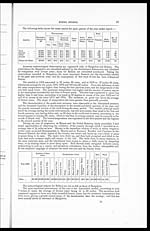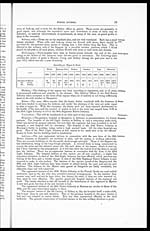Medicine - Institutions > Army health reports and medical documents > Medical and sanitary reports of the native army of Madras > Medical and sanitary report of the native army of Madras for the year 1876
(63) Page 54
Download files
Individual page:
Thumbnail gallery: Grid view | List view

54
MEDICAL AND SANITARY REPORT OF THE NATIVE ARMY OF MADRAS.
The rainfall at Bellary has been less of late years that it was formerly, and probably a
large part of the Ceded Districts suffers in the same way, which opens a wide question as to the
causes which are in operation and under which the face of this part of India is slowly changing.
Both monsoons were equally deficient in 1876. The season is reported by the medical officers
(without referring to the meteorological statistics) as one of dry heat and the cold weather more
marked than usual. At the French Rocks the rainfall was deficient, and the thermometer has
shown a much higher degree of temperature for a longer time than is usual at this station.
At Mysore there was a great deficiency of rain during the year, only 22 inches and 80¾ cents
having fallen; the average rainfall is about 30 inches per annum.
At Mercara in Coorg the climate is reported to have been milder than that of the two
previous years.
Sanitary.
Sanitary. —The subject of sanitation is receiving great but not undue attention at the
present day. It is by its means, rather than by any improvement in the treatment of disease,
that we can hope to reduce the mortality of the civil and military population. The means of
bringing it to bear on the general population are, however, very scanty and indirect. We can
apply sanitary rules to our hospitals and jails, and to the barracks and lines of Native
soldiers. We can also, to a certain extent, impose them on towns and villages through the
instrumentality of Municipalities and Local Fund Boards. In the course of time it may be
possible by such means to leaven the entire mass of the people with a sense of the value of
sanitary measures, and to imbue them with the feeling that it is better to be clean and live,
than be dirty and die. That consummation is, however, a long way off yet. The road is long
and difficult, and many an obstacle must be removed or surmounted before light and air can be
let into every nook and corner of the moral jungle.
The regimental lines are carefully attended to and kept as clean and free from nuisances
as their construction will admit of, with the exception of those of the Sappers and Miners and
of the Left Wing of the 36th Regiment Native Infantry at Bangalore. The old mud hut with
flat, or tiled, or thatched roof and mud wall enclosure, without light or ventilation, except what
it receives through the door, is still the typical residence of the sepoy and his family. The
wonder is that with such a place to live in, which he often shares with five or six members of
his family, the sepoy makes such a creditable appearance as he does; but constant care and
watchfulness on the part of the European officers prevent the occurrence of nuisances or
sanitary evils in the lines, at least, outside the huts. Until however Government undertake
to build suitable quarters for the sepoys, similar to those now being erected for the 36th
Regiment Native Infantry, with a system of impervious drains and regimental latrines, it will
not be possible to affirm that the lines of the sepoy regiments are in a satisfactory condition.
With the two exceptions just mentioned, in which V-section stone-lined drains are laid down,
the drainage is effected by mere furrows in the ground. I am far, however, from condemning
this kind of drain in a dry climate, such as that of Bellary for instance, where the rainfall is
light and where the means of regularly flushing the drains do not exist. In my opinion it is
better, under such conditions, that the wash from the houses should be disposed of by partial
absorption into the earth—the great filter and purifier of all foulness—where it would be
retained and rendered harmless till washed away by the periodical rains, than that it should lie
exposed to the sun in an impervious drain in which it stagnates and stinks. In none of the
lines which I have lately inspected did I perceive such an abominable stench as was emitted
by the stone-lined surface drains of the Sappers when their contents were being stirred by the
sweeper's brooms. This may seem a heresy in sanitation, but sanitary science is still in its
infancy and has yet much to learn from the experience of age. Its principles are true, but their
application must be regulated by circumstances which are almost infinite in their variety and
combination.
As with drains so it is with public latrines. They are desirable if they can be kept clean
and worked on strict principles of sanitation; otherwise it would be better for the people to
revert to their primitive mode of fertilizing the fields.
In such a station as Mercara, however, stone-lined drains are necessary. The water rushes
down in such torrents during the rainy season, that the channels are hollowed out into deep
holes, and their sides are washed away. They have to be removed every year in consequence.
The lines of the Left Wing of the 28th Native Infantry at Mercara have been rebuilt on a
more regular plan and better site, and the health of the men has improved in consequence, still
they are only separated by a few yards from one of the dirtiest villages to be found in all India,
the inhabitants of which keep large herds of buffaloes, which are brought into the village every
night. The removal of this village, which it is said might be bought up for 3,000 Rupees,
has been often recommended, and, until it is done, no matter how clean and well conserved the
regimental lines may be, the men will always be exposed to danger from their dirty neigh-
bors, both occupying on oval bowl-shaped hollow of very limited dimensions. The lines of the
23rd Regiment W. L. I. at Bangalore and those of the 4th Light Cavalry at Bellary are badly
situated, being close to the native bazaar. It is probable that both will be rebuilt before long,
and their faulty position will then have to be considered and rectified.
Barracks and
guard-room.
Barracks and guard-room. —The barracks of Native corps are used as places of arms.
The quarter guard is also accommodated there. There is generally a guard-room, defaulter's
Set display mode to: Large image | Zoom image | Transcription
Images and transcriptions on this page, including medium image downloads, may be used under the Creative Commons Attribution 4.0 International Licence unless otherwise stated. ![]()
| Permanent URL | https://digital.nls.uk/74991493 |
|---|




